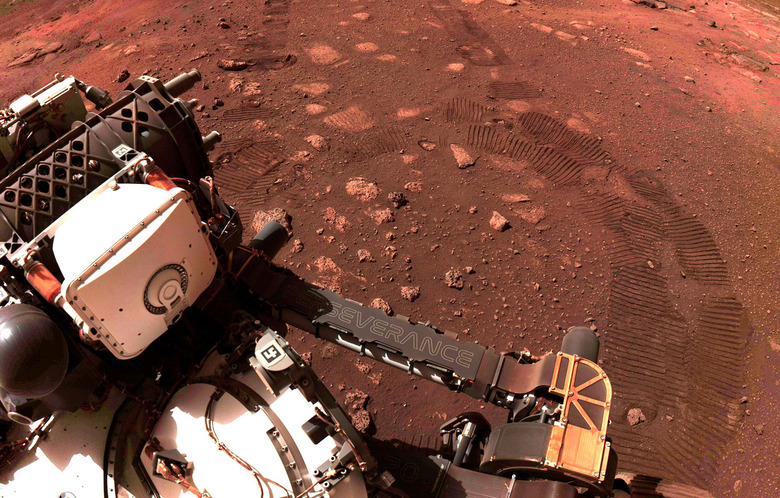NASA's Perseverance Takes Its First Steps, Er, I Mean Rolls
It's now been a couple of weeks since NASA's Perseverance rover landed safely on Mars. The mission almost never left Earth due to the coronavirus pandemic but NASA managed to squeeze the launch in at the very last moment and, after months of travel, the rover managed to stick its landing perfectly. Of course, the main thing a rover has to do is, well, rove, so it's great to see that NASA's Jet Propulsion Laboratory posted a snapshot of the high-tech robot's tracks in the dusty Martian soil.
The rover spent most of its first two-ish weeks proving that it was still healthy. After such a long trip through space and a landing on another planet, the rover could have experienced any manner of component failures, so giving all the systems a check was first on NASA's list. All of the rover's instruments were given a clean bill of health and, after receiving a command to take its first "steps" on Mars, it traveled across the surface.
As NASA's Jet Propulsion Laboratory explains in a new blog post, the rover traveled 21. 3 feet. That might not seem like much but it was really the final test that showed that all aspects of the rover are working as intended. Now that it's clear that the rover is ready for whatever Mars can throw at it, the real fun can begin.
"When it comes to wheeled vehicles on other planets, there are few first-time events that measure up in significance to that of the first drive," Anais Zarifian, Mars 2020 Perseverance rover mobility test bed engineer, said in a statement. "This was our first chance to 'kick the tires' and take Perseverance out for a spin. The rover's six-wheel drive responded superbly. We are now confident our drive system is good to go, capable of taking us wherever the science leads us over the next two years."
The rover is easily the most impressive piece of technology ever to be sent to Mars, and it'll be capable of exploring the planet in a way that has never been done before. The robot will be capable of navigating the planet for huge stretches at a time, with NASA planning on the rover exploring for up to 200 meters (656 feet) at a time before waiting for additional commands.
In addition to whatever scientific discoveries the rover can make on its own — and we can assume it'll make many of them — the mission will also serve as the starting point for the first Mars sample return mission NASA has ever attempted. The rover will seal sample capsules to be picked up at a later date and carried back to Earth by subsequent missions. Getting samples of the Red Planet into a laboratory on Earth could yield even more exciting discoveries, but we'll have to wait for those for the time being.
